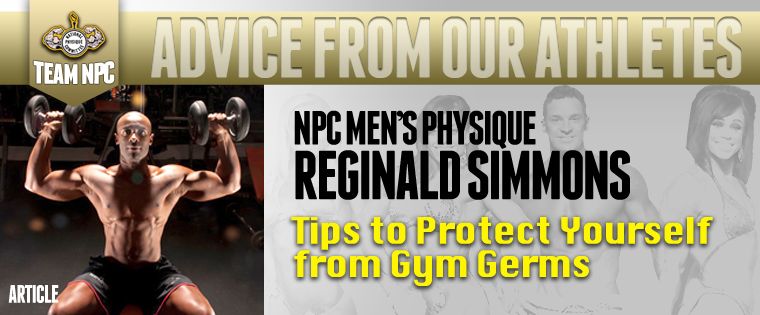NPC Men’s Physique Reginald Simmons
Tips to Protect Yourself from Gym Germs
Have you ever heard of the word fomite? No? A fomite is an inanimate object that can become contaminated by an infected person then serve as a source infection for others. The best fomites are non-porous, solid objects like door handles, elevator buttons and counter tops just to name a few. Once infected these surfaces are capable of transmitting bacterial, viral and fungal infections without discrimination.
So why should you care about fomites? Great question. And, I have an even better answer. Gyms are a perfect breeding ground for infections, for instance dumbbells, benches and locker room floors are excellent fomites. Think about it. How many times have you seen someone leave the restroom without washing their hands as they head out into the weight area? What about the gal that keeps coughing and sneezing without covering her mouth? And let’s not forget about the guy that drips sweat all over the weight bench. All of these people are potential shedders and spreaders of infection.
According to a position paper released by the National Athletic Trainers’ Association, the nature of athletics expose the skin to a wide variety of stresses. Vigorous exercise, environmental factors and infectious agents act together to continually attack the integrity of the skin and challenge the immune system. The successful results of these attacks are infections and colds. In fact, one of the most common type of infections picked up in gyms are skin infections. Other infections include things like ringworm, herpes simplex, influenza, HPV, E. coli, staph and MRSA.
Expected & unexpected sources of infection
The list of expected and unexpected culprits involved in the transmission of infections is fairly extensive. Here is an abbreviated list of the more common culprits that can be found in any standard gym.
|
|
Before you give up on going to the gym all together, continue reading for a couple of ways to reduce your risk.
1. Use disinfectant Sprays
So you might be thinking that you’re protected from the germs listed above because you use the disinfectant spray provided by your gym. Well if you beleive this, then you’d only be partially right.
A study published in the Clinical Journal of Sports Medicine demonstrated that twice-a-day the equipment was disinfected and still wasn’t effective in reducing virus exposure. The study found that 63% of the exercise equipment in two gyms were contaminated with viruses, namely rhinovirus. Rhinovirus is the primary cause of the common cold. Certainly I’m not suggesting that you stop using disinfectant sprays because they do help…a little. Honestly you may even want to purchase your own personal can of disinfectant spray versus using the watered down stuff that your gym provides.
2. Don’t touch your face
Believe it or not, you can actually infect yourself with viruses like rhinovirus and influenza. If you touch infected surfaces then rub your eyes or wipe your mouth, you’ve just introduced an infection to your body. The solution is to stop touching your face—problem solved.
3. Create a Barrier
I would suggest that you create a barrier between yourself and the equipment that you use. A simple towel can provide you with an effective barrier, however if you’re feeling fancy you can pick up the pocketed TowelMate with its Germ Shield Technology (www.towelmate.com). In addition to being used with equipment, towels should be used on locker room benches—including those in the steam room.
Shower shoes or flip-flops are also a must as fungal infections like athlete’s foot and plantar warts, caused by HPV, are easily spread in warm, moist locker rooms and shower stalls. If you have any open cuts, sores or skin abrasions, then you’ll want to cover them with a bandage or Band-Aid.
4. Shower with antimicrobial soap
Showering with an antimicrobial soap from head-to-toe is recommended to kill any germs you may have come into contact with. The National Athletic Trainers’ Association recommends that you shower prior to leaving the gym. Why? Because you can easily transport germs with you.
5. Wash all athletic gear daily
While non-porous materials are the best fomites, your clothes, weight gloves and weight belt can also become infected if they come into contact with viruses, bacteria or fungi. And by all means you should also wash your gym bag and lifting straps.
Through careful planning and adherence to the above tips, you can go a long way towards protecting yourself from potentially serious infections.
Facebook: https://www.facebook.com/Fitnupe1911
Instagram / Twitter: Fitnupe1911
Email: Fitnupe1911@gmail.com
Sources:
Clinical Journal of Sport Medicine, Prospective Study of Bacterial and Viral Contamination of Exercise Equipment, http://journals.lww.com/cjsportsmed/Abstract/2006/01000/Prospective_Study_of_Bacterial_and_Viral.7.aspx
Men’s Fitness, http://www.mensfitness.com/training/pro-tips/the-7-grossest-gym-germs
National Athletic Trainers’ Association Position Statement: Skin Diseases, www.nata.org/position-statements





